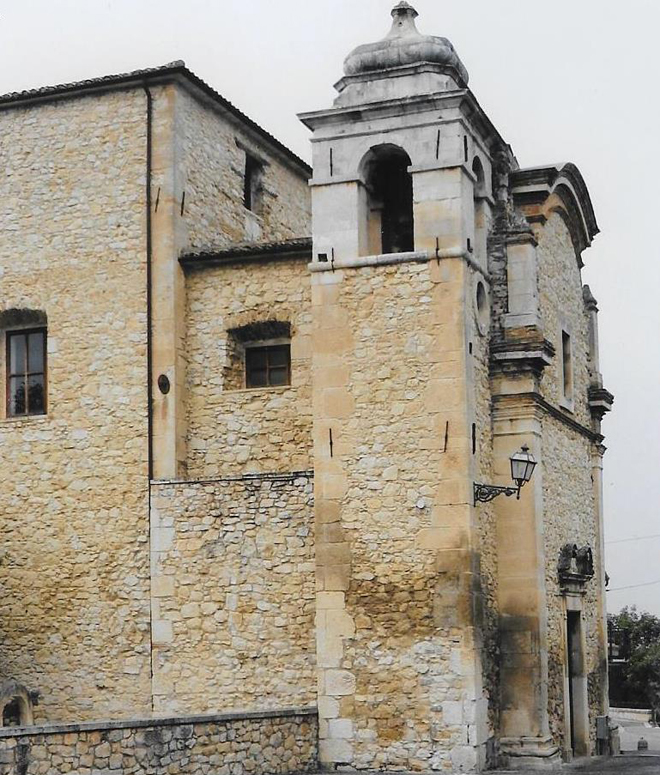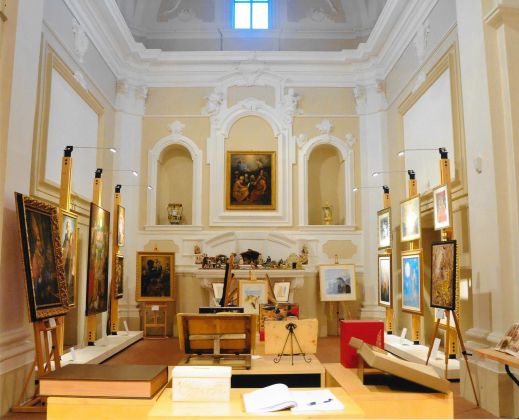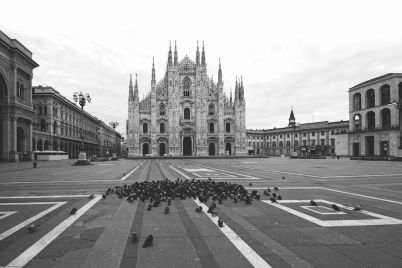To honour his hometown of Roccamorice in the mountains of Abruzzo, Alberto Di Giovanni established an exquisite cultural museum in a restored chapel in the heart of the village. The project began about 10 years ago when the municipality was able to fund the reconstruction of the “Baron’s Chapel,” a private chapel of the Barone Giuseppe Zambra.
A tall, square, stone tower had stood near the edge of the precipice siince medieval times. In the early 18thcentury, the baron commissioned the construction of a chapel with a vaulted ceiling and large windows to be added to the existing tower, resulting in the private chapel the noble family used from 1703 until 1806, the year the Emperor Napoleon dismissed noble families throughout Italy and secularized their chapels.
The chapel stood abandoned for nearly two centuries, and was further damaged by the 1980 earthquake. Finally, in 1986 the town of Roccamorice received funding for the chapel’s restoration. The work was carried out by architects Roberto Damiani and Daniele Rosati. Care was taken to follow the Baroque style windows, vault, altars, and nave of the original church, adding a stabilized entrance with safe access to the choir loft above.

Photo by Annamaria Di Giovanni
Once the project was completed, the mayor and councillors had to find a good use for the beautiful space. The town used the newly restored chapel occasionally for meetings, and the parish put it to use when the parish church was under renovation. The municipal authorities eventually invited their native son, Alberto, to find a way to bring the place to life. It was opened as the Centro d’Arte e Cultura “Alberto Di Giovanni” in the summer of 2011.
Roccamorice, like many small communities in the Maiella range, has a population of barely 1000. Before World War II, it was much larger, with families of shepherds, farmers, and foresters. The town was occupied by the Germans during the war because of its strategic location overlooking the Adriatic. There are stories of partisans saving Allied soldiers lost in the rugged environment.
When the conflict ended, many of the villagers decided to emigrate to look for work in other parts of the world. A large number chose to come to Ontario; the chain of family members sponsoring each other brought thousands to Toronto in the 1950s and 60s. Among them was the Di Giovanni family, of whom seven brothers and two sisters, as well as the parents, came to settle in the Greater Toronto Area. Only the eldest son, Giuseppe, remained in the town. Alberto, the second-youngest, enrolled in the pre-university year at St. Michael’s College in 1966, progressed very well even as he was learning English, and graduated in 1971, with an Honours B.A. from the University of Toronto. He married Caroline Morgan, also a St. Michael’s graduate, in 1972.
Alberto dedicated his career to the promotion of Italian language and culture in Canada. He established the Centro Scuola e Cultura Italiana (the Canadian Centre for Italian Culture and Education) in 1976, in Toronto, where the Italian community numbered a half-million. Through Centro Scuola, Alberto and other community leaders succeeded in establishing the Heritage Languages programs in school boards throughout the Greater Toronto Area. Elementary school students could learn Italian during the school day, where families consented. Other languages such as Portuguese, Spanish, Greek, and Mandarin, could also be offered in schools with these students.
By 1986, Alberto also organized high school summer credit programs, bringing young people in their teens to stay in Italian towns for three weeks, taking classes every morning, and experiencing village life in the afternoons. These students went on excursions to Rome, Florence, Ferrara, Perugia, Verona, and Venice as they earned credits towards their graduation. An autumn session was added later.

Photo by Luca Codignola-Bo
All of these learning experiences served to strengthen the connections between generations within Italian families, helping children communicate with their parents and grandparents in their mother tongue. Students were also exposed to the rich cultural heritage of Italian artists, history, architecture, music, and social life. Alberto led the students and teachers with vibrant enthusiasm. Whenever possible, the students would make a trip up the steep roads to the monastery of Santo Spirito a Maiella, and the local town, Roccamorice. Having so many Canadian young people visit the town year after year convinced the mayor and council to offer the reconstructed site to Alberto, trusting that he would find a lasting purpose for the beautiful space.
During his 35 years as Director of Centro Scuola, Alberto took part in Canadian and International conferences on multiculturalism, language education, and community development. He met writers, artists, politicians, and publishers, and he became acquainted with some of the main ceramic studios in Italy. As a result, he acquired paintings and ceramics, rare books, signed first editions, and numbered facsimile editions of the Codex of Leonardo Da Vinci. His particular interest in the Divina Commedia by Dante Alighieri resulted in a fine collection of special editions of this timeless work.
By 2010, when the Chiesa del Barone in Roccamorice was ready for use, Alberto was prepared to donate many of his treasures for display in the new location. The local pastor, Don Gilberto Ruzzi, had become involved with saving artworks from various churches in the area, having these centuries-old paintings restored to prevent deterioration. The religious collection and Alberto’s many books, paintings, and ceramics together fill the nave and altars of the chapel. Even the choir loft provides a bright setting for a group of paintings by Canadian artists who toured Italy with Alberto’s guidance, and donated their works in gratitude.
This jewel of a museum opened with a concert in the piazza outside the restored church in July 2011. The town authorities have named it Centro d’Arte e Cultura “Alberto Di Giovanni” in honour of their native son. Alberto himself will say this lovely place pays tribute to the thousands of Roccolani who emigrated in difficult times but who continue to cherish their Italian and Abruzzese heritage.



